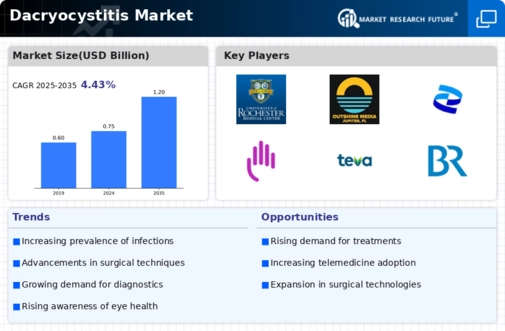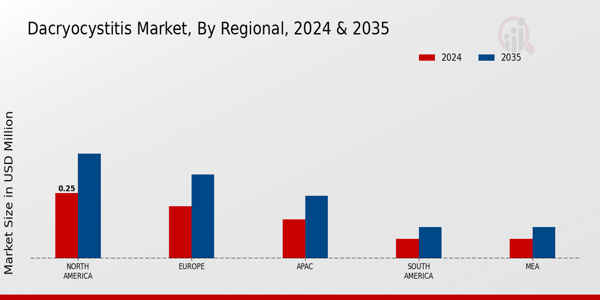Growing Geriatric Population
The increasing geriatric population globally is a notable driver for the Global Dacryocystitis Market Industry. As individuals age, they become more susceptible to various health conditions, including those affecting the tear ducts. The World Health Organization projects that the number of people aged 60 years and older will double by 2050, which could lead to a corresponding rise in dacryocystitis cases. This demographic shift necessitates the development of targeted treatment strategies and healthcare services, thereby creating opportunities for growth within the market.
Rising Awareness and Education
There is a growing awareness regarding dacryocystitis among both healthcare professionals and the general public, which serves as a significant driver for the Global Dacryocystitis Market Industry. Educational campaigns and resources provided by health organizations are helping to inform individuals about the symptoms and treatment options available. This heightened awareness encourages early diagnosis and intervention, which can lead to better patient outcomes. As more people recognize the importance of seeking medical attention for eye-related issues, the demand for dacryocystitis treatments is likely to increase, further propelling market growth.
Advancements in Medical Technology
Technological innovations in medical devices and surgical techniques are transforming the Global Dacryocystitis Market Industry. Minimally invasive procedures, such as endoscopic dacryocystorhinostomy, have gained traction, offering patients quicker recovery times and reduced complications. The integration of advanced imaging techniques allows for more accurate diagnoses, thereby enhancing treatment outcomes. As these technologies become more widely adopted, they are likely to drive market growth. The increasing demand for effective and efficient treatment options may further stimulate investments in research and development, ultimately benefiting the industry as a whole.
Government Initiatives and Funding
Government initiatives aimed at improving healthcare access and funding for eye health are crucial drivers of the Global Dacryocystitis Market Industry. Various health departments and organizations are allocating resources to enhance diagnostic and treatment facilities for eye diseases, including dacryocystitis. These initiatives often include subsidies for medical treatments and support for research into new therapeutic options. As governments prioritize eye health, the market is expected to benefit from increased funding and resources, which may lead to improved patient care and expanded treatment options.
Increasing Prevalence of Dacryocystitis
The rising incidence of dacryocystitis is a pivotal driver for the Global Dacryocystitis Market Industry. Factors such as aging populations and increased exposure to environmental irritants contribute to this trend. For instance, older adults are more susceptible to conditions affecting the tear ducts, leading to higher rates of dacryocystitis. As a result, the market is projected to grow from 0.75 USD Billion in 2024 to approximately 1.2 USD Billion by 2035, reflecting a compound annual growth rate of 4.37% from 2025 to 2035. This growing prevalence underscores the need for effective treatment options and healthcare resources in the industry.























Leave a Comment